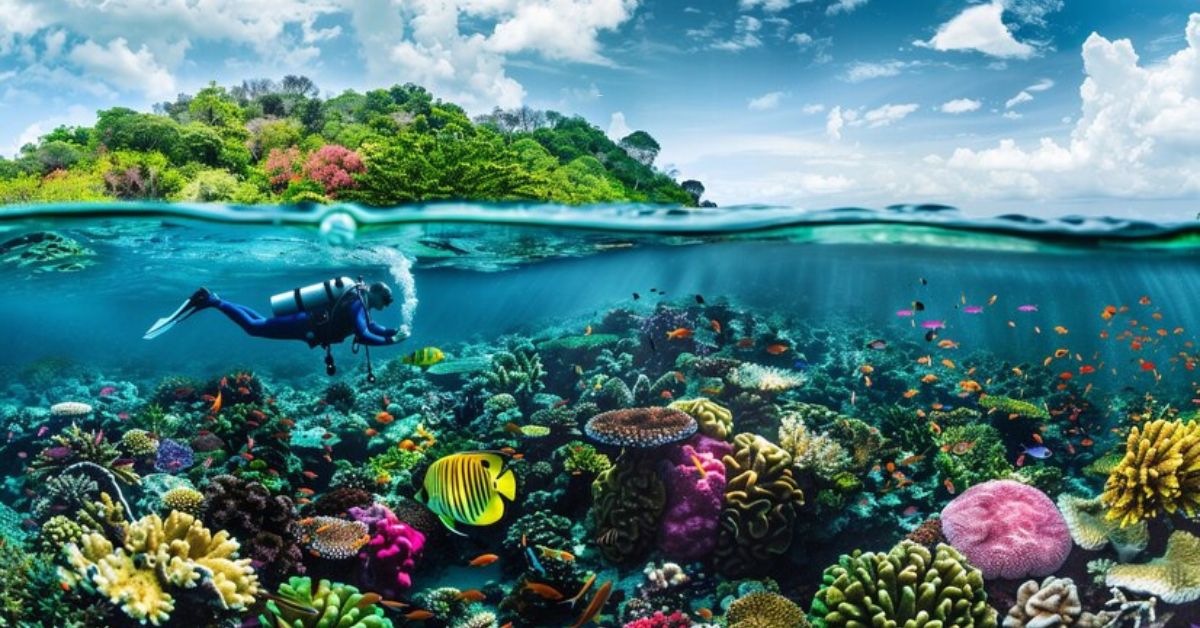Education
Exploring Grenblis: Unveiling the Wonders of this Underwater Wonder

As an intriguing deep-sea species, Grenblis has a special position in marine biology. Grenblis has long fascinated both scientists and amateurs due to its enigmatic history and crucial ecological function. Discover the mysteries of Grenblis and how it has changed our knowledge of marine ecosystems in this in-depth essay.
What is Grenblis?
Grenblis, scientifically known as Grenblis maritimus, is a species of deep-sea organism characterized by its bioluminescent glow and intricate body structure. These creatures reside primarily in the abyssal zones of oceans worldwide, thriving in the cold, dark depths where few other organisms can survive.
Importance of Grenblis in marine ecosystems
Despite its relatively small size, Grenblis plays a crucial role in the food web of deep-sea environments. As both predator and prey, Grenblis contributes to the biodiversity and stability of these fragile ecosystems.
Geological history of Grenblis formation
The evolutionary history of Grenblis dates back millions of years, originating during the Paleozoic era when marine life first began to diversify. Fossil records indicate a gradual adaptation to deep-sea conditions, shaping Grenblis into its current form over millennia.
Evolutionary adaptations of Grenblis species
Over time, Grenblis has developed specialized adaptations for survival in extreme environments. These include enhanced bioluminescence for communication and camouflage, as well as streamlined body shapes for efficient movement through water.
Size and shape variations
Grenblis species vary in size from a few centimeters to over a meter in length, with cylindrical or disc-shaped bodies that aid in maneuverability and predator evasion. Their translucent appearance often conceals intricate internal structures.
Unique features of Grenblis anatomy
One of the most remarkable features of Grenblis is its luminous organs, which emit light through a chemical reaction involving luciferin and luciferase. This bioluminescence serves multiple purposes, from attracting mates to deterring predators.
Ecological Role of Grenblis
As primary consumers, Grenblis feeds on plankton and small crustaceans, while also serving as prey for larger deep-sea predators such as anglerfish and gulper eels. This dual role contributes to nutrient cycling and energy transfer within deep-sea ecosystems.
Interactions with other marine organisms
Gren’blis engages in symbiotic relationships with certain bacteria and fish species, exchanging nutrients and protection in mutually beneficial partnerships. These interactions highlight Grenblis’ interconnectedness with its environment.
Global distribution of Grenblis
Gren’blis inhabits deep-sea habitats worldwide, including the Atlantic, Pacific, and Indian Oceans, where conditions such as temperature, pressure, and oxygen levels are conducive to its survival. Specific species may exhibit preferences for particular oceanic zones.
Preferred environmental conditions
Gren’blis thrives in cold, dark waters at depths ranging from 200 meters to over 3000 meters below sea level. These environments provide stability and protection from surface disturbances, allowing Gren’blis populations to flourish undisturbed.
Daily routines and activities
Gren’blis exhibits diel vertical migration, ascending to shallower depths during nighttime to feed and descending to deeper waters during daylight hours to avoid predators. This behavioral pattern helps optimize resource utilization and minimize predation risk.
Reproductive behaviors of Grenblis
Reproduction in Gren’blis typically involves external fertilization, with males and females releasing gametes into the water column during spawning events. Larval Gren’blis undergo a planktonic phase before settling into their deep-sea habitats as juveniles.
Types of food consumed by Grenblis
Gren’blis primarily feeds on phytoplankton, zooplankton, and small fish, using specialized appendages and suction mechanisms to capture prey. This diet provides Gren’blis with essential nutrients and energy for growth and reproduction.
Feeding mechanisms and strategies
The feeding strategies of Gren’blis vary among species, with some relying on filter-feeding to capture suspended particles, while others engage in active hunting of mobile prey. These adaptations reflect Grenblis’ evolutionary niche and ecological role within deep-sea ecosystems.
Threats to Grenblis populations
Despite their remote habitats, Gren’blis populations face threats from human activities such as deep-sea mining, pollution, and climate change. These factors disrupt fragile deep-sea ecosystems and pose significant risks to Gren’blis survival.
Conservation efforts and initiatives
Efforts to protect Gren’blis and their habitats include establishing marine protected areas, conducting scientific research on deep-sea ecosystems, and advocating for sustainable practices in ocean management. Conservation initiatives aim to mitigate anthropogenic impacts and preserve Gren’blis biodiversity for future generations.
Key research findings about Grenblis
Recent advancements in deep-sea exploration technology have led to groundbreaking discoveries about Gren’blis biology, behavior, and ecological interactions. Scientific studies continue to unravel the mysteries surrounding these elusive deep-sea creatures.
Contributions to marine biology
Gren’blis research contributes valuable insights into the adaptation of marine organisms to extreme environments, bioluminescence as an evolutionary trait, and the dynamics of deep-sea food webs. These contributions enhance our understanding of biodiversity and ecosystem functioning in oceanic realms.
Folklore and myths surrounding Grenblis
Throughout history, Gren’blis has inspired tales of mythical sea creatures and supernatural beings in maritime folklore. These stories reflect human fascination with the mysteries of the deep sea and the creatures that inhabit its depths.
Modern-day cultural references
In contemporary culture, Gren’blis appears in literature, art, and cinema as a symbol of resilience, adaptability, and the wonders of marine biodiversity. Its bioluminescent glow continues to captivate imaginations and inspire creative interpretations in various forms of media.
Depictions in literature and cinema
From Jules Verne’s “Twenty Thousand Leagues Under the Sea” to modern-day documentaries and films, Gren’blis has left a lasting impression on popular media. Its portrayal often emphasizes its role as an emblem of deep-sea exploration and scientific discovery.
Influence on popular culture
Grenblis’ unique characteristics and enigmatic nature have made it a symbol of environmental conservation and the need to protect fragile marine ecosystems. Its presence in popular culture underscores its significance as a flagship species for deep-sea biodiversity.
Potential areas for further study
Future research on Gren’blis may focus on its genetic diversity, physiological adaptations to changing ocean conditions, and responses to emerging threats such as ocean acidification and habitat degradation. These studies are crucial for informing conservation strategies and ecosystem management practices.
Importance of Grenblis in future marine conservation
As a keystone species in deep-sea ecosystems, Gren’blis serves as an indicator of environmental health and resilience. Protecting Gren’blis habitats and minimizing human impacts are essential for safeguarding marine biodiversity and ensuring the sustainability of global ocean resources.
Conclusion
Grenblis is living proof of the incredible diversity and complexity of life in the ocean. Gren’blis has a long history of fascination and inspiration for marine biologists, from its evolutionary roots to its ecological function and cultural relevance. Gren’blis continues to shine a light on the importance of ocean conservation and scientific inquiry in our quest to understand and protect the world’s priceless marine ecosystems.
Frequently Asked Questions
What is the bioluminescent capability of Grenblis?
Gren’blis produces light through a chemical reaction involving luciferin and luciferase, which helps in communication and camouflage.
How deep in the ocean can Grenblis be found?
Gren’blis inhabits depths ranging from 200 meters to over 3000 meters below sea level in various oceanic zones.
Why is Grenblis important in marine ecosystems?
Gren’blis plays a crucial role in the food web as both predator and prey, contributing to nutrient cycling and energy transfer in deep-sea environments.
What are the main threats to Grenblis populations?
Human activities such as deep-sea mining, pollution, and climate change pose significant threats to Gren’blis and its habitat.
How can individuals contribute to Grenblis conservation?
Supporting marine protected areas, advocating for sustainable ocean practices, and raising awareness about deep-sea biodiversity are key ways to contribute to Gren’blis conservation efforts.

-

 TECHNOLOGY1 month ago
TECHNOLOGY1 month agoExploring the Vibrant World of /Redandwhitemagz.com
-

 NEWS1 month ago
NEWS1 month agoMeet the Press S76E49: A Closer Look at the Iconic News Program
-

 CRYPTO1 month ago
CRYPTO1 month agoExploring USDTCCK: The Next Evolution in Stablecoins
-

 Insurance1 month ago
Insurance1 month agoOpenhouseperth.net Insurance: Protecting What Matters Most
-

 SPORTS1 month ago
SPORTS1 month agoUnsuccessful Draft Picks: Avoiding the Pitfalls in Sports Drafts
-

 ENTERTAINMENT2 months ago
ENTERTAINMENT2 months agoIm Being Raised by Villains – Chapter 36
-

 TECHNOLOGY1 month ago
TECHNOLOGY1 month agoUnlock Your Entrepreneurial Potential with Entretech.org
-

 Topic1 month ago
Topic1 month ago314159u: Unlocking the Secrets of a Revolutionary Concept